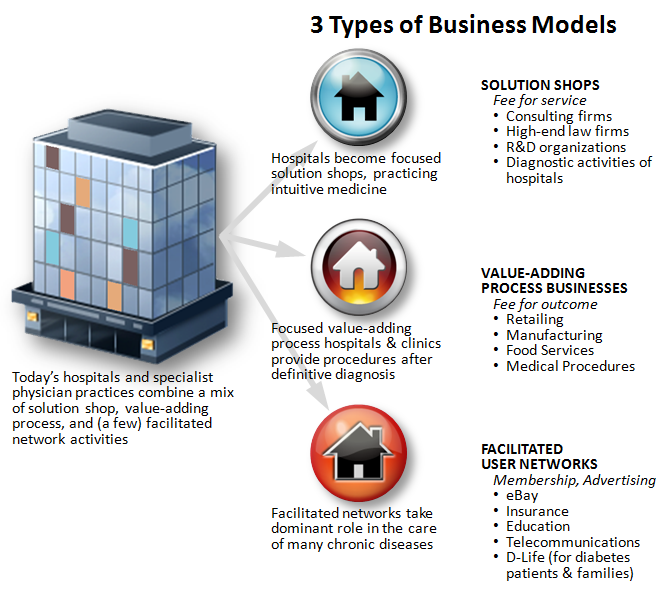Innovator’s Prescription: Disruptive Healthcare Solution
 Harvard Business School’s Clayton M. Christensen — whose bestselling book, The Innovator’s Dilemma, revolutionized the business world — now presents The Innovator’s Prescription, a comprehensive analysis of the strategies that will improve health care and make it affordable.
Harvard Business School’s Clayton M. Christensen — whose bestselling book, The Innovator’s Dilemma, revolutionized the business world — now presents The Innovator’s Prescription, a comprehensive analysis of the strategies that will improve health care and make it affordable.
In this meaty 87-min lecture at MIT, Professor Christensen explains how you can’t believe everything you learn in business school and reveals insights into such socially significant and complex industries as health care. “It’s the principles of good management that can cause successful companies to fail,” he says.
The lecture introduced concepts from his latest book, where Christensen applies his principles of disruptive innovation to the broken health care system. With collaboration from two pioneers in the field — Dr. Jerome Grossman and Dr. Jason Hwang — he examines a range of symptoms and offers proven solutions.
I initially was able to embed the video of Christensen’s MIT lecture within the article, but they have since moved it to a site that doesn’t let me copy the embed code. So, you can either follow the link above to watch at MIT.edu or watch a related lecture (in five parts below) from a Partnerships in Clinical Trials event.
|
|
In the lecture and book, you’ll discover how:
- Disruptive business models improve quality, accessibility and affordability by changing the way hospitals and doctors work;
- “Precision medicine” reduces costs and makes good on the promise of personalized care;
- Patient networks enable better treatment of chronic diseases; and
- Employers can change the roles they play in health care to compete effectively in the era of globalization.
While the trend of Moore’s Law makes digital technologies smaller, faster and cheaper so they can move down-market, new competition moves up-market. From studying lots of industries, Christensen found example after example where an entrant company came in and killed the leaders by simplifying technology and making it more affordable, foolproof and idiot-simple. As these little guys pursued low profit segments of industries with more efficient and lower-cost methods, the big established companies fought to hold onto segments that offered higher profits margins.
Affordable health care, Christensen concludes, “doesn’t come by expecting high end, expensive institutions to become cheap, but by bringing technology to lower cost providers and venues of care, so they can become more capable.” But he cautions that solutions should target real problems and not just perceived ones.
“If you develop a product or service that helps people do something more affordably and conveniently, something they’re not trying to do, it just never works. Even if they should do it, if they’re not trying to do it, it never works. A lot of problems with wellness programs: becoming healthy is not a job people try to do until they’re really sick. ”
Disruptive Health Care Predictions
Today’s intuitive medicine is based on trial-and-error, because just a few symptoms such as temperature, pulse, blood pressure, diabetes and hypertension are used to diagnose a great many types of disease and estimate the probability of good outcomes from treatment alternatives. At the genetic level, however, our bodies can more precisely show what’s wrong. That’s why advancements in molecular diagnostics, imaging technologies and high-bandwidth telecommunications will enable disruptive business models in health care and facilitate a move from intuitive models to empirical medicine and personalized precision medicine.
Innovative technologies such as smartphones and cloud services will enable the use of medical diagnostic and treatment tools with less skill and at less cost, their use will move down-market from specialists to nurse practitioners and even to family caretakers, as shown below.


Where will this innovation come from?
It’s unlikely to come from incumbents with established business models. Instead, it will come from new entrants using disruptive business models, but Christensen notes that business models must fit within economic systems, and those systems too must change.
An example of such change is seen with medical tourism and specialty hospitals. See:
- Lessons from Healthcare Innovation in India
- Are we Bringing Health Care Home or Sending it Overseas?
- TeleHealth: The Doctor Will See You Now, Remotely and
- Medical Tourism Around the World
The current economic system of general hospitals, fee-for-service reimbursement, blanket contracting, physician practices and licensing regulations is starting to give way to a new system.
The new system includes HSAs & high-deductable insurance, accountable care organizations with financial incentives based on health, solution shops & value-added process hospitals, chronic care through user networks, personal health records, retail clinics, and direct employer contracting. Christensen also observed that government regulations that initially encourage innovation often evolve to protecting old models.
The ideal entity responsible for healthcare should have a long-term horizon, strong motivations to keep people healthy, and the ability to make care convenient. Of the potential options listed below, employers seem most likely to fulfill that role.
- Employers
- Employees
- Insurance / reimbursement firms
- Doctors & hospitals
- Government
Employers are already starting to provide primary health care for their employees to keep them productive, often with self-insurance financing and by contracting directly for services when needed.
|
COMPARE THESE COSTS: |
Shouldice Hospital |
General Hospital |
|
Cost of materials & supplies |
$100 |
$300 |
|
Cost of direct labor |
$600 |
$670 |
|
Overhead burden |
$1,600 |
$6,030 |
|
Cost of equivalent length of stay |
$2,300 |
$7,000 |
|
# service families offered |
1 |
75 |
|
Overhead burden rate |
2.7 |
9.0 |
|
Source: Clayton M. Christensen |
||


